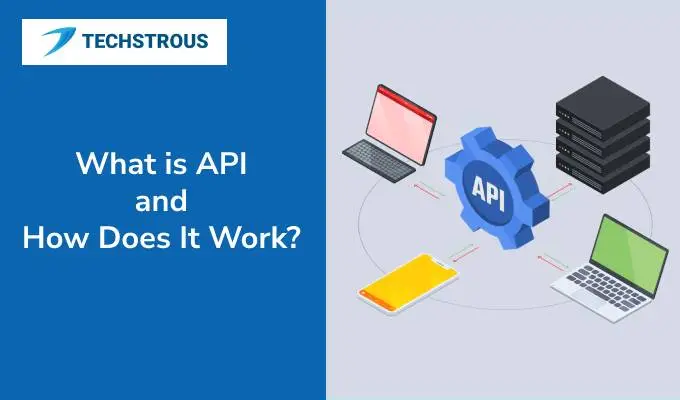Overview
You may have heard about API, but you might not have complete information about this term. What is API, How does it work and what are its characteristics? If you are looking for answers to these questions, you are on the right page. Here, we discuss everything about API that you should know. Whether you are a technical person or from a non-tech background, this article will provide a radical understanding of API. So, read till the end.
What is API?
API or Application Program Interface consists of rules or protocols that enable data transfer and communication across multiple applications. Moreover, it specifies the formats and methods of data transfer between these applications.
An example is Payment Processing API, like PayPal, which makes online transactions possible for any non-tech user. It requests your account details from the bank server and in return, it receives the desired information.
Why are APIs important?
With the help of API, an application can access the required information from another system. The database can only permit the request of authorized applications (that have the security key) and send the information requested. Thus, the complete process becomes safe, seamless, and swift through the API.
Different Types of APIs
There are numerous types of APIs, however, some of the most prominent types of APIs are specified below:
#1. Public/Open APIs: These APIs are open and available for the public without any restriction. Therefore, they can use the API in their application/software and call out the desired information. Applications like OLA, Uber, etc., use Google Maps API.
#2. Partner APIs: Unlike open APIs, partner APIs use a controlled data transfer between two or more parties (often referred to as partners). An authentication mechanism is employed to ensure that only desired parties can access data.
A hotel booking app that enables you to get the best deals on certain hotels is an example.
#3. Internal/Private APIs: Limited to only a particular organization, it is the most restricted API. Developers use internal APIs to call data from the company server. A banking application displays the account details of the customer by communicating with the concerned banking server.
#4. Composite APIs: A composite API enables sending a single request and calling out multiple pieces of information at once. Consider an example of a food-delivering application. When you choose a combo meal in which multiple food items are requested, a composite API is utilized.
Also Read: Best App Development Tools to Create Application for Free
Protocols and Architecture of APIs
API protocols and architecture define the approach to data transfer. It specifies what format a particular API uses and how it processes the information. Although there are multiple API architectural protocols used, we are sharing some of the most widely accepted and prominent types.
#1. REST (Representational State Transfer): REST API is the web API architectural principle. It uses a client-server model in which Uniform Resource Identifiers (URIs) are used instead of resources to get information.
It employs standard HTTP methods like GET, POST, PUT, DELETE, etc. for communication of different systems over the internet. This API architectural protocol is simple, widely popular, and can be used across different programming languages.
#2. RPC (Remote Procedure Call): In this API protocol, the application calls a function to a remote server which performs the procedure and returns the result, just like the function is called on a local code.
It makes remote communication a calling normal function. This architecture employs different formats (JSON, XML, gRPC) for transmitting data, unlike REST which only uses JSON.
#3. SOAP (Simple Object Access Protocol): It supports multiple communication protocols like HTTP, SMTP, and TCP/IP. It is more rigid than REST because of the structured XML format. Moreover, it is extendable which allows developers to use it as needed.
It is a robust architecture. Thus, suitable for enterprise purposes like banking, and government services. It is a messaging protocol that exchanges structured data in XML format between systems over a network. It sends a request to the server in a structured XML format which further processes the request and sends the result back to the system.
How Does an API Work?
The working of an API can be better understood with an example. Consider booking a restaurant for dinner. API will perform the following task as specified:
Step 1: First, you search for your nearby restaurants using the application. The interface is simple and you can easily type in English.
Step 2: The inbuilt API reads the request. It then converts it into a format suitable for communication and then sends the request to the server.
Step 3: The server which is mostly third-party receives the request process. It brings out the desired output from the database and then sends it back to the API of your mobile application.
Step 4: Now, the API receives the result in coded format. It converts the received information into a user-friendly format.
Step 5: Finally, it displays the restaurant names in your nearby location along with details like addresses, timing, etc.
All the above processes are carried out in a fraction of a second. This way API provides the desired output without having the complete details of all the restaurants.
Benefits of API Integration
Integrating APIs has numerous benefits for users, developers, and businesses:
#1. Automation: Eliminating the requirement of manual requests, APIs make the process automated. Instead of manually adding your favorite game and granting permission to your Facebook account, you just have to click the Connect with Facebook icon.
#2. Efficiency: For developers writing the script to communicate with the database of third parties is no longer needed. They can simply use the corresponding API.
#3. Scalability: Any application can be connected to any other system with the help of APIs. So, you can add as many functionalities to the application as needed.
#4. Lightweight Applications: As the data can be fetched from the database of another system, the size of the application and complexity of the code are reduced to a significant extent.
#5. Security: The most beneficial aspect of implementing APIs is that they add an additional layer of security. Only authorized applications can collect data from the system as it asks for a security key for any request made.
Real-Life Applications of API
APIs are integrated into almost every software that requires communication and provides information. We are sharing some of the most popular API examples that you encounter in your everyday life.
Google Map API
Google Map API is a very popular example in the list. It enables adding the Google map function into an application. Therefore, whenever you see a map feature in any application like a food or product delivery app, it is because the Google Map API is added to that application.
Moreover, it enables customization to add some additional features and graphics.
Weather API
Any web or mobile application that displays weather information and associated parameters uses the weather API. You can get real-time weather forecasts, temperature, humidity, etc., of different places. Moreover, you can get upcoming weather forecasts based on past reports.
Social Media API
This is another popular example in the list. You may have experienced that whenever you sign up for an application or service, an option to log in via Facebook appears on the screen.
After providing the desired login credentials, this new website automatically displays your name and associated details. It is because of the Facebook API. Similarly, there are other social media APIs that provide basic user details like name, profile picture, posts, etc., to the third-party application.
PayPal API
This API helps in managing banking accounts and processing transactional and financial details. Because of this API, you can easily transfer money and access your bank account information like current balance, last transaction, availed services, etc.
E-Commerce API
Although this e-commerce API consists of multiple APIs, its main function is to manage online commerce, providing information about available products, process payments, order details, etc.
Conclusion
APIs are very crucial for any web or mobile application or software. It helps for swift and smooth information exchange between multiple systems without any security concerns. Moreover, it enables adding new functionalities to the existing software easily. Therefore, it is beneficial for users, developers, and businesses in every aspect.
Frequently Asked Questions
What is the API full form?
API stands for Application Program Interface. It is a set of rules for exchanging information over the internet between different systems without accessing a complete database.
What are the different types of API?
The four major API types are:
- Public/Open API
- Partner API
- Internal/Private API
- Composite API
What are real-life API Examples?
Some of the most popular API examples are Google Map API, Social Media APIs, Weather API, Payment Processing API, and E-Commerce API.




